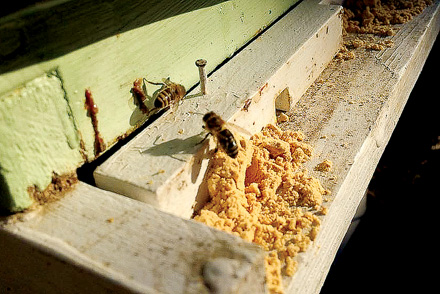Bring It, Winter

I may be one of the few people you know who wants it to be cold again. It’s not for me, it’s for my honeybees.
Bees don’t hibernate. They cluster in a ball inside the hive, shivering to keep warm. That’s why they store honey, to give them carbohydrates over winter to generate heat. If they don’t have baby bees to keep warm, they keep the inside of the hive at around 70F. If they have the nursery going, they raise the temperature to 90F.
When outside temperatures go above 40F, bees leave the hive to relieve themselves. With temperatures in the 60s, bees think it’s early spring and look for pollen to take back to the hive for food. The flying around and lack of nectar and pollen means they also consume more of their stored honey,
Based on past winters, beekeepers make sure their hives have enough honey to get them through at least February. This will be a year when a lot of us will be way off estimating how much honey our bees needed.
On Christmas 2016, when the temperatures were in the 60s, my bees had already moved into the second story of their hive, a good month earlier than usual. They also had most of their honey consumed, so I gave them sugar cakes I make as supplemental food. I usually give them the sugar cakes early February but I didn’t want to risk them dying of starvation if cold weather ever returned and I couldn’t get into the hives to feed them.
The warmer temperatures have also meant my bees have been out foraging, looking for pollen. Their favorite spot has been my birdfeeders, where I have sunflower seeds, cracked corn and a dash of sand mixed together. It’s been fun watching and photographing bees burying themselves in the bird seed trying to find the cracked corn dust. My birds haven’t been too amused.
I have also been feeding my bees pollen substitute in small buckets on the ground under the bird feeders. The buckets have sticks inside so the bees can safely land, load up on pollen in their back leg pouches and carry it back to the hive.
The pollen substitute is a mixture of soybean flour, brewers yeast, milk powder, vitamin C and brewers yeast.
Just to make sure everyone was getting a supply, I also dabbed pollen substitute on the front of the hives, next to their little front doors. When I first checked back a couple of hours later, it was all gone, carefully packed and carried into the hive so I just kept adding more.
If temperatures ever go below 40F, the bees will huddle again inside the hive and not eat as much honey.
On the other hand, having bees out and about hasn’t been so bad. I love having them around and they do a pretty good job of scaring squirrels out of my birdfeeders.
Charlotte Ekker Wiggins is a beekeeper, gardener and sometimes cook. Published by El Dorado Springs Sun with permission. Copyright 2017, all rights reserved. Contact Charlotte at chargardens@gmail.com.

LOVABLE THIEVES – My honeybees raiding a bird feeder for the cracked corn dust to take back to the hive for food.

HONEY DEW PROJECT – I fed my colonies pollen substitute at the front of the hive so they would have extra food in case they run out of honey this winter.
(Photos by Charlotte Ekker Wiggins).



Facebook Comments